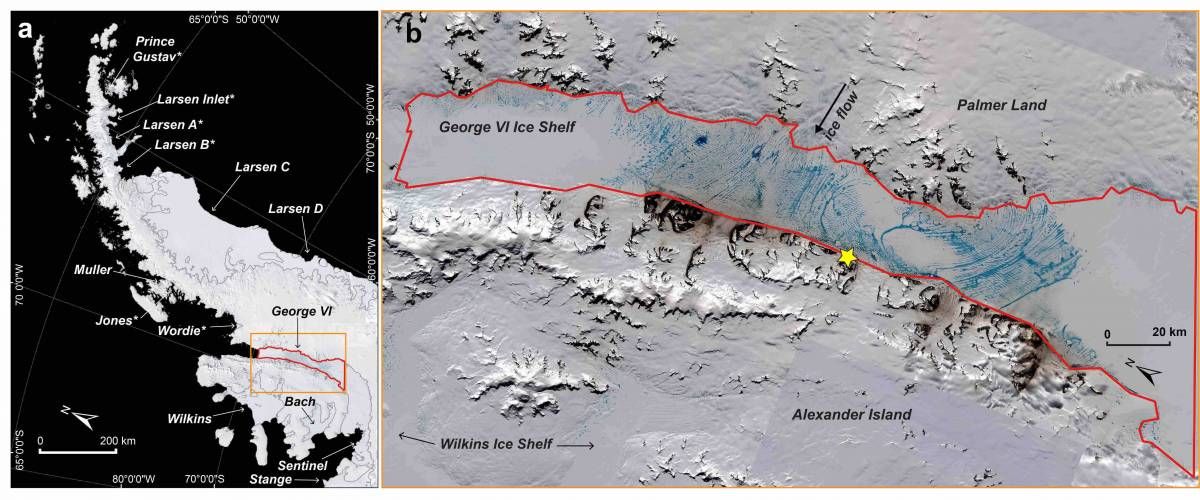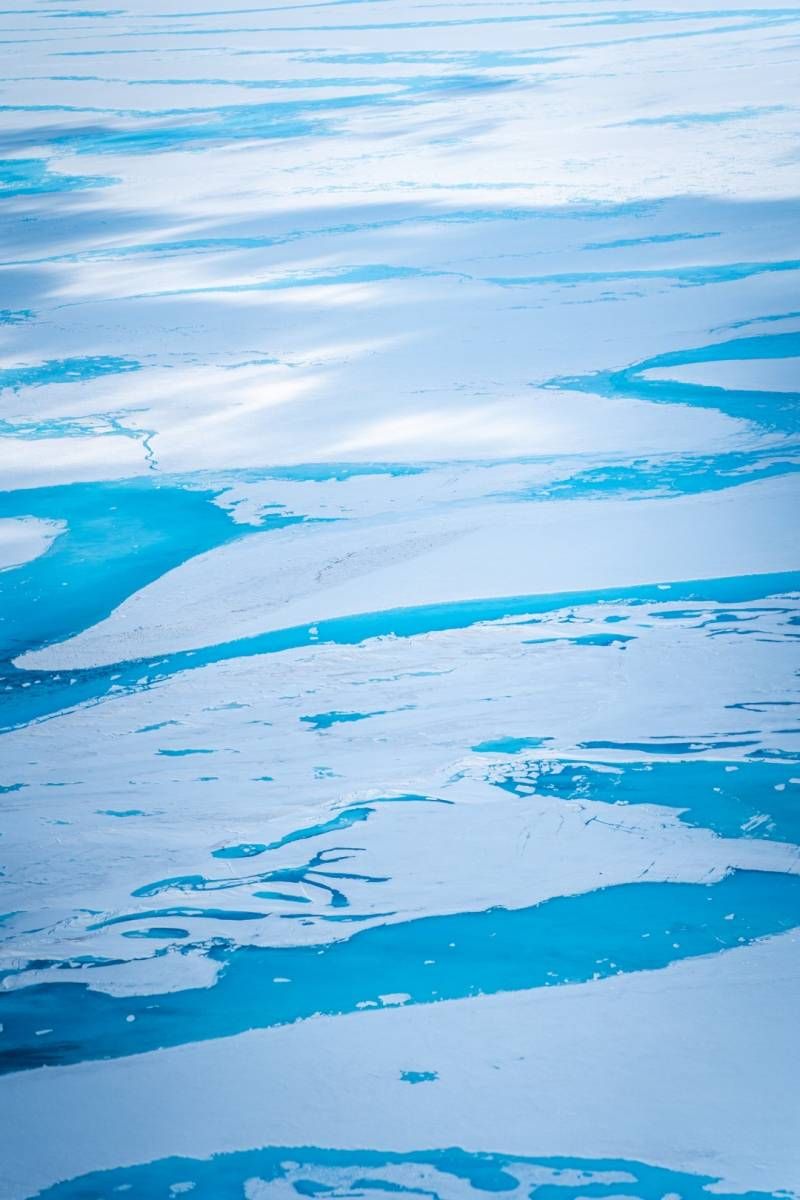Extreme melt on Antarctica’s George VI ice shelf

Antarctica’s northern George VI Ice Shelf experienced record melting during the 2019-2020 summer season compared to 31 previous summers of dramatically lower melt, a CU Boulder-led study found. The extreme melt coincided with record-setting stretches when local surface air temperatures were at or above the freezing point.
“During the 2019-2020 austral summer, we observed the most widespread melt and greatest total number of melt days of any season for the northern George VI Ice Shelf,” said CIRES Research Scientist Alison Banwell, lead author of the study published today in The Cryosphere.
Banwell and her co-authors—scientists at CU Boulder’s National Snow and Ice Data Center and the Department of Atmospheric and Oceanic Sciences, NASA Goddard and international institutions—studied the 2019-2020 melt season on the northern George VI Ice Shelf using a variety of satellite observations that can detect meltwater on top of the ice and within the near-surface snow.
Surface meltwater ponding is potentially dangerous to ice shelves, according to Banwell, because when these lakes drain, the ice fractures and may trigger ice-shelf break-up. “The George VI Ice Shelf buttresses the largest volume of upstream grounded ice of any Antarctic Peninsula ice shelf. So if this ice shelf breaks up, ice that rests on land would flow more quickly into the ocean and contribute more to sea level rise than any other ice shelf on the Peninsula,” Banwell said.

THE LEFT IMAGE IS A MOSAIC OF SATELLITE OPTICAL IMAGES OVER THE ANTARCTIC PENINSULA FROM THE MODIS INSTRUMENT. THE STUDY AREA IS OUTLINED IN RED AND THE ORANGE BOX DEPICTS THE AREA SHOWN ON THE RIGHT. THE RIGHT IMAGE IS A MOSAIC OF SATELLITE OPTICAL IMAGES FROM SENTINEL-2 AND LANDSAT 8 FROM JANUARY 17 AND 19, 2020. BLUE SURFACE MELTWATER PONDS COVER 23 PERCENT OF THE STUDY AREA, AND THE YELLOW STAR SHOWS THE LOCATION OF THE FOSSIL BLUFF WEATHER STATION. CREDIT: BANWELL ET AL. (2021), FIG. 1.
The 2019-2020 melt season was the longest for the northern George VI Ice Shelf—the second largest ice shelf on the Antarctic Peninsula—but it wasn’t the longest melt season over the entire peninsula: the 1992-1993 melt season was the longest. But as air temperatures continue to warm, increased melting on the northern George VI Ice Shelf and other Antarctic ice shelves may lead to ice-shelf break-up events and ultimately sea-level rise.
To determine the factors that caused the record melt on the northern George VI Ice Shelf, the researchers examined local weather data—including surface temperature, relative humidity, wind direction, and wind speed—from the British Antarctic Survey’s Fossil Bluff weather station on the ice shelf’s western margin.
Banwell and her colleagues documented several multi-day periods with warmer-than-average air temperatures that likely contributed to the exceptional melt of 2019-2020. “Overall, a higher percentage of air temperatures during the 2019-2020 season—33 percent—were at or above zero degrees Celsius (32 degrees Fahrenheit) compared to any prior season going back to 2007,” Banwell said.

A CLOSE-UP OF MELTWATER LAKES ON THE GEORGE VI ICE SHELF TAKEN FROM A BRITISH ANTARCTIC SURVEY TWIN OTTER AIRCRAFT IN JANUARY 2020. CREDIT: THOMAS SIMONS
The researchers identified periods from late November onwards when temperatures were consistently above the freezing point for up to 90 hours. “When the temperature is above zero degrees Celsius, that limits refreezing and also leads to further melting. Water absorbs more radiation than snow and ice, and that leads to even more melting,” Banwell said.
To detect surface melt over large areas, the researchers used satellite microwave data. “Microwave data lets us look at the brightness temperature of the surface and the near surface snow, which indicates whether or not there is meltwater present,” Banwell said. Observations going back to 1979 showed that the extent and duration of surface melt on the northern George VI Ice Shelf in 2019-2020 were greater than the 31 previous summers.
Next, the researchers used satellite imagery to calculate the volume of meltwater on the George VI Ice Shelf, finding that the 2019-2020 melt season had the largest volume of surface meltwater since 2013. Meltwater ponding peaked on January 19, 2020, when satellite images showed 23 percent of the entire study area covered in water, with a total volume of 0.62 km3—equal to about 250,000 Olympic-size swimming pools.
Banwell’s research on ice-shelf stability includes a field project funded by the National Science Foundation. During the researchers’ first field season in November 2019, they installed instruments to measure changes in elevation, lake depth and weather conditions on the northern George VI Ice Shelf. “We were due to go back in November 2020, but that was canceled due to COVID,” Banwell said. “We hope to return later this year when it's once again safe to pursue field work in this remote region of Earth.”